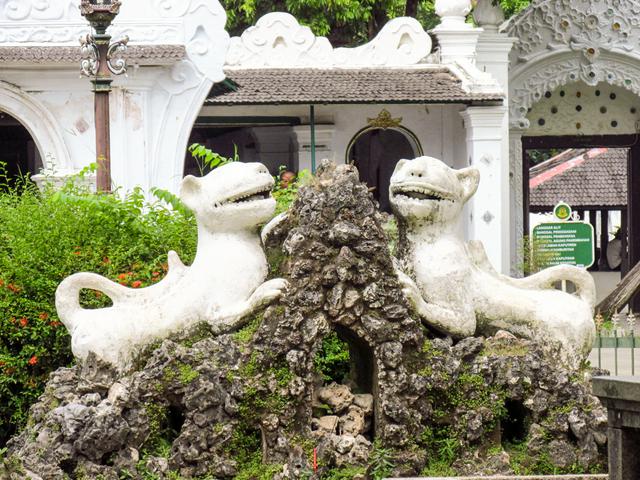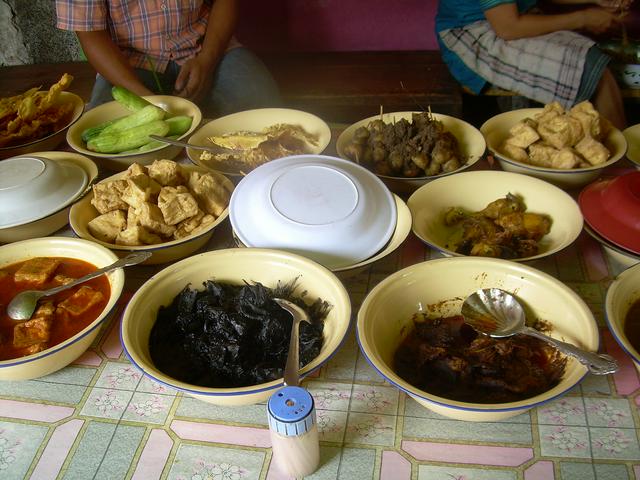Cirebon is a city in the North Coast region of West Java, not far from the border with Central Java.
Its name is often said to be derived from the Sundanese words of 'ci' (water or river) and 'rebon' (shrimp). Indeed, the city's main industry is fishery, including shrimps. An alternative Javanese explanation is that the city's name is from caruban', meaning "mixture", a reference to Cirebon's complex mix of Javanese, Malay, Sundanese, Chinese and Arabic cultural elements. While Indonesians from outside of Cirebon pronounce the name CHEE-reh-bon, locals say Cheer-BON (with rolling R).
The city weather is hot and humid. Wear cotton clothes. You do not need long sleeves shirt, instead a T-shirt and knee-long trousers are comfortable. Some places like mosques and temples require polite dress such as long trousers/skirts. Hot pants/mini skirts may attract unwanted attention and might be considered impolite.
 Keraton Kasepuhan, Jalan Kasepuhan No. 43. Daily 8:00-17:00, except Fridays 7:00-11:00 and 14:00-16:00. The oldest sultan palace in Cirebon, built in 1447. The decoration on the inside is interesting, being a curious combination of styles. For example, apart from the Sundanese, Javanese, and Islamic decorations, you may find Dutch Delft blue-and-white tiles. Entrance for foreigners Rp50,000 on weekdays, Rp70,000 in weekends. Discounts for students.
Keraton Kasepuhan, Jalan Kasepuhan No. 43. Daily 8:00-17:00, except Fridays 7:00-11:00 and 14:00-16:00. The oldest sultan palace in Cirebon, built in 1447. The decoration on the inside is interesting, being a curious combination of styles. For example, apart from the Sundanese, Javanese, and Islamic decorations, you may find Dutch Delft blue-and-white tiles. Entrance for foreigners Rp50,000 on weekdays, Rp70,000 in weekends. Discounts for students.- Keraton Kanoman, Jalan Winaon Kampung Kanoman. The second sultan palace, established when there was a division in the Cirebon sultanate in the 17th century. This palace is not as well-maintained as the Kasepuhan palace.
- Cirebon Kejaksan railway station building, Jl. Tanda Barat I / Jl. Stasiun. The station building of Cirebon's main railway station was built during the colonial time, based on a design by Dutch architect Pieter Adriaan Jacobus Moojen. The building is a good example of New Indies Style, combining modern European architecture with local elements.
- Grave of Sunan Gunungjati, Jl. Sunan Gunung Jati (off Jl. Raya Indramayu-Cirebon. Sunan Gunungjati was one of the wali sanga, revered saints of Islam in Indonesia in the 15th century. He was the founder of both the Sultanate of Banten and the Sultanate of Cirebon. Just as the graves of the other wali sanga, his grave is a local pilgrimage site.
- Gua Sunyaragi
Keraton Kasepuhan, Jalan Kasepuhan No. 43. Daily 8:00-17:00, except Fridays 7:00-11:00 and 14:00-16:00. The oldest sultan palace in Cirebon, built in 1447. The decoration on the inside is interesting, being a curious combination of styles. For example, apart from the Sundanese, Javanese, and Islamic decorations, you may find Dutch [[Delft]] blue-and-white tiles. Entrance for foreigners Rp50,000 on weekdays, Rp70,000 in weekends. Discounts for students.
Keraton Kanoman, Jalan Winaon Kampung Kanoman. The second sultan palace, established when there was a division in the Cirebon sultanate in the 17th century. This palace is not as well-maintained as the Kasepuhan palace.
Cirebon Kejaksan railway station building, Jl. Tanda Barat I / Jl. Stasiun. The station building of Cirebon's main railway station was built during the colonial time, based on a design by Dutch architect Pieter Adriaan Jacobus Moojen. The building is a good example of New Indies Style, combining modern European architecture with local elements.
Grave of Sunan Gunungjati, Jl. Sunan Gunung Jati (off Jl. Raya Indramayu-Cirebon. Sunan Gunungjati was one of the wali sanga, revered saints of Islam in Indonesia in the 15th century. He was the founder of both the Sultanate of [[Banten (town)|Banten]] and the Sultanate of Cirebon. Just as the graves of the other wali sanga, his grave is a local pilgrimage site.
Cirebon is a centre of batik cloth industry. The special 'Batik Cirebon' style can be bought in many places around the city.
- Yogya Grand Toserba, Jalan Karanggetas. Located at the heart of the city, this Toserba (toko serba ada meaning "shop that sells everything") has4 floors: 1st floor - shoes & bags department, 2nd floor - ladies wear & mens wear, 3rd floor - supermarket, 4th floor - Marina Restaurant.
- CSB Mall Cirebon, Jl. Doktor Cipto Mangunkusumo No. 26. Daily 10:00-22:00. Shopping centre with a wide range of shops and cafés, as well as a large supermarket and XXI cinema.
Yogya Grand Toserba, Jalan Karanggetas. Located at the heart of the city, this Toserba (toko serba ada meaning "shop that sells everything") has4 floors: 1st floor - shoes & bags department, 2nd floor - ladies wear & mens wear, 3rd floor - supermarket, 4th floor - Marina Restaurant.
CSB Mall Cirebon, Jl. Doktor Cipto Mangunkusumo No. 26. Daily 10:00-22:00. Shopping centre with a wide range of shops and cafés, as well as a large supermarket and XXI cinema.
 Cirebon is known for a few local dishes, often with fish and seafood products, but also other dishes that show the city's mixture of Sundanese and Javanese influences. Below is a list of some popular local eateries that serve these local dishes.
Cirebon is known for a few local dishes, often with fish and seafood products, but also other dishes that show the city's mixture of Sundanese and Javanese influences. Below is a list of some popular local eateries that serve these local dishes.
- Nasi Jamblang Mang Dul, Jalan Doktor Cipto Mangunkusumo No. 58, +62 231 206 564. Daily 5:00 (AM) - 1:00 (AM). Local 'nasi jamblang' cuisine: a buffet with dishes such as tofu vegetables, liver or meat stews, potatoes, fried eggs, cooked chili, stewed fish, etc. Key characteristic is the use of teak tree leaves to pack the rice.
- Nasi Lengko H. Barno, Jalan Doktor Cipto Mangunkusumo (next to Nasi Jamblang Mang Dul, +62 812 2277 3991. Daily 8:00-22:00. Nasi lengko consists of steamed rice, tempeh and tofu, and bean sprouts, covered with peanuts sauce, garlic chives, and sweet soysauce on top. It is usually served with mutton satay and tapioca starch crackers.
- Sate Kalong Jalan Kesambi Dalam, Jalan Kesambi Dalam No.102. Daily 19:00-23:00. Sate kalong is Cirebon-style buffalo satay. The word 'kalong' means 'bat', which refers to that the buffalo satay is usually only sold after dark.
- Tahu Gejrot Wardi, Jl. Lemah Wungkuk / Kanoman. Tahu Gejrot is a spicy tofu dish. It is sold throughout the city at streetfood stalls, often for only about Rp5,000 per portion. A well-known seller is Tahu Gejrot Wardi at the corner of the Kanoman market, near the Kanoman palace.
- Empal Gentong H. Apud, Jl. Raya Ir. H. Djuanda No. 24, +62 231 211 055. Daily 9:00-21:00. Local spicy curry-like beef soup. H. Apud is a famous restaurant selling this dish.
- Empal Gentong & Empal Asam Amarta, Jl. Ir H Juanda No. 37, Plered. Daily 9:30-21:00. Empal asam is the same as empal gentong, but a small star fruit is added, and no coconut is used, making the taste more sour.
Nasi Jamblang Mang Dul, Jalan Doktor Cipto Mangunkusumo No. 58, +62 231 206 564. Daily 5:00 (AM) - 1:00 (AM). Local 'nasi jamblang' cuisine: a buffet with dishes such as tofu vegetables, liver or meat stews, potatoes, fried eggs, cooked chili, stewed fish, etc. Key characteristic is the use of teak tree leaves to pack the rice.
Nasi Lengko H. Barno, Jalan Doktor Cipto Mangunkusumo (next to Nasi Jamblang Mang Dul, +62 812 2277 3991. Daily 8:00-22:00. Nasi lengko consists of steamed rice, tempeh and tofu, and bean sprouts, covered with peanuts sauce, garlic chives, and sweet soysauce on top. It is usually served with mutton satay and tapioca starch crackers.
Sate Kalong Jalan Kesambi Dalam, Jalan Kesambi Dalam No.102. Daily 19:00-23:00. Sate kalong is Cirebon-style buffalo satay. The word 'kalong' means 'bat', which refers to that the buffalo satay is usually only sold after dark.
Tahu Gejrot Wardi, Jl. Lemah Wungkuk / Kanoman. Tahu Gejrot is a spicy tofu dish. It is sold throughout the city at streetfood stalls, often for only about Rp5,000 per portion. A well-known seller is Tahu Gejrot Wardi at the corner of the Kanoman market, near the Kanoman palace.
Empal Gentong H. Apud, Jl. Raya Ir. H. Djuanda No. 24, +62 231 211 055. Daily 9:00-21:00. Local spicy curry-like beef soup. H. Apud is a famous restaurant selling this dish.
Empal Gentong & Empal Asam Amarta, Jl. Ir H Juanda No. 37, Plered. Daily 9:30-21:00. Empal asam is the same as empal gentong, but a small star fruit is added, and no coconut is used, making the taste more sour.
- Restaurant Seafood Jumbo, Jalan Siliwangi No. 191, +62 231 203 606. Daily 10:00-22:00.
- Marina, Jalan Parujakan No. 2A, +62 231 210 033. Daily 10:30-21:00.
Restaurant Seafood Jumbo, Jalan Siliwangi No. 191, +62 231 203 606. Daily 10:00-22:00.
Marina, Jalan Parujakan No. 2A, +62 231 210 033. Daily 10:30-21:00.
- Mount Ciremai National Park — the highest mountain of West Java province, just south of Cirebon.
- Linggajati — point of entrance to Mount Ciremai, and also the location of the 1946 Linggajati Agreement (now a museum).
- Indramayu — to the northwest, Indramayu has various beaches along the Java Sea coast, as well as a few offshore islands.
